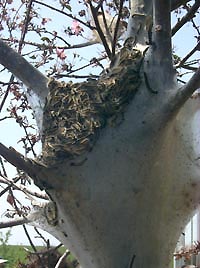Eastern and Forest Tent Caterpillars Feeding; Timing Right for Horse Farms to Implement Control Strategies
Eastern and Forest Tent Caterpillars Feeding; Timing Right for Horse Farms to Implement Control Strategies

Experts report that eastern tent caterpillars and forest tent caterpillars are developing normally this spring with egg hatching complete and populations feeding, making this an optimal time for area horse farms to assess caterpillar activity and implement control strategies while the larvae are still small and most susceptible.
“There is no indication of widespread high populations of the eastern tent caterpillar this year”, said Lee Townsend, University of Kentucky College of Agriculture entomologist. There are, however, abundant populations of the caterpillar in some localized areas.
Townsend added that this week’s freezing nighttime temperatures won’t adversely affect populations of the eastern tent caterpillar.
“The eastern tent caterpillar is an early spring insect so it typically faces erratic weather patterns like abnormal warm or cold spells” he explained. “It is well-protected by its ‘hairy’ body insulation and aggregating (gathering) with other caterpillars in the tents.”
Controlling eastern tent caterpillars is vital to area horse farms, as UK research has strongly linked the caterpillars with outbreaks of Mare Reproductive Loss Syndrome (MRLS), which can cause late-term foal losses, early-term fetal losses and weak foals.
During 2001, when MRLS hit Central Kentucky particularly hard, an estimated 30 percent of the 2002 Thoroughbred foal crop was lost and the state suffered an economic cost of approximately $336 million due to losses suffered in all breeds of horses.
Epidemiological and field studies conducted by UK researchers demonstrated that MRLS was associated with unprecedented populations of eastern tent caterpillars, wild black cherry trees and waterfowl on horse farms in Kentucky. A series of studies over the next five years has subsequently revealed that horses will inadvertently eat the caterpillars and that the caterpillar hairs embed into the lining of the alimentary tract. Once that protective barrier is breached, normal alimentary tract bacteria may gain access to and reproduce in sites with reduced immunity, such as the fetus and placenta. Fetal death from these alimentary tract bacteria is the hallmark of MRLS.
Now is an optimal time for controlling populations because the caterpillars are still gathered together in the trees, Townsend said. Currently, small caterpillars are moving to feed on the leaves that have been appearing in trees and have built tents at branch and limb forks.
“Initial growth of the caterpillars will be slow, but over the next two to three weeks caterpillars in limb nests will begin to move to the main truck branches and join together in a smaller number of large tents on individual trees. This aggregation behavior can be used advantageously to manage the caterpillars by destroying or treating accessible populations,” he said.
After a few weeks, the caterpillars will leave the trees where they’ve eaten the available foliage and search for food to complete their development. Once the caterpillars have reached these dispersing stages, controlling them becomes much more difficult, Townsend said.
Townsend offered the following recommendations for controlling populations. “Foliar sprays for caterpillar control can be made during this time period. Spray residues of products based on Bacillus thuringiensis (Bt) must be eaten by small caterpillars to be effective; there is no contact effect. Consequently, applications should be made to as much of the canopy as is feasible, especially the foliage around active nests. Direct application to nests will not provide any control. Bt residues on foliage can be broken down by sunlight in three to four days so it is important to assess control and re-treat if necessary. Effectiveness of Bt decreases as caterpillar size increases,” he explained.
“Foliar sprays with products such as bifenthrin (Talstar) or carbaryl (Sevin) have both stomach and contact activity so they can be effective when sprayed on foliage or tents. The residual life of carbaryl is about a week; that of bifenthrin is at least two to three weeks. Another option is to inject trees with either bidrin (Inject-A-Cide “B” or 2 percent Abacide). Regardless of the treatment used, it is important to revisit the sites in about five days to assess caterpillar activity,” he said.
Additionally, experts recommend that horse farms scout for the telltale white tents in cherry and crabapple trees and err on the side of caution by keeping mares away from any caterpillar locations.
Townsend also explained that forest tent caterpillars have been at outbreak levels along the Ohio River for the past two years and appear abundant in the Boone County area. The forest tent caterpillar is similar to the eastern tent caterpillar and Townsend didn’t rule out the possibility that it could cause similar problems in horses as the eastern tent caterpillar does. He added that the forest tent caterpillar does not seem to be active in Central Kentucky.
